MARIANI’SVirtual Gourmet
July 15,
2012
NEWSLETTER

❖❖❖
THIS
WEEK
by John Mariani
NEW YORK CORNER
Gwynnett Street
by John
Mariani
NOTES FROM THE WINE
CELLAR
Sancerre
by John Mariani
Boston Bites
by John Mariani

Recently a friend in Houston boasted about the breadth and depth of her city's restaurant scene, and I said that I thought Houston could easily compete with Boston on that score. Her eyebrows shot upwards: "Boston? Where would you eat in Boston?"
Right now, here's where.
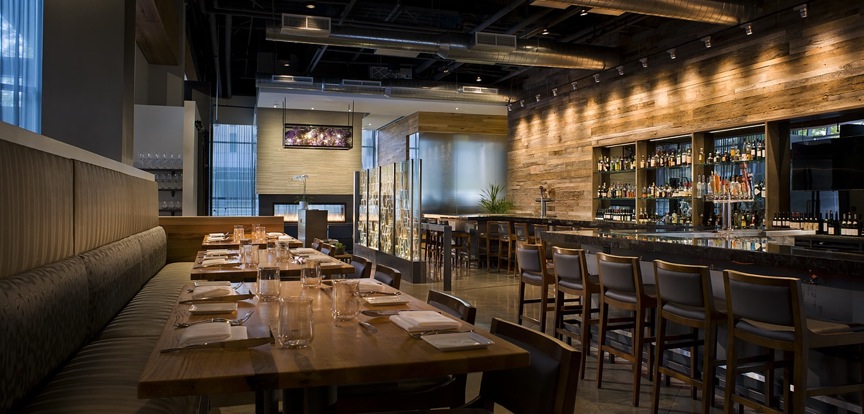 CATALYST
CATALYST
300 Technology Square, Cambridge
617-576-3000
www.catalystrestaurant.com
Technology Square is a
new hot spot, not just for the macro-nerds at MIT
but for the businesses that have grown up around it,
and everyone needs good places to eat and drink.
These include Area
Four, Bondir, and the newest, Catalyst, a
large, expansive mix of minimalist modernism and
evocations of New England farm décor.
Chef/owner William Koval is doing equally balanced
American cuisine with a distinct nod to the
seasonal, so the menu changes often. In summer and early autumn, the al
fresco patio is the place to dine.
When I ate there, the menu of 20
items showed off the range of New England's bounty,
from garden to 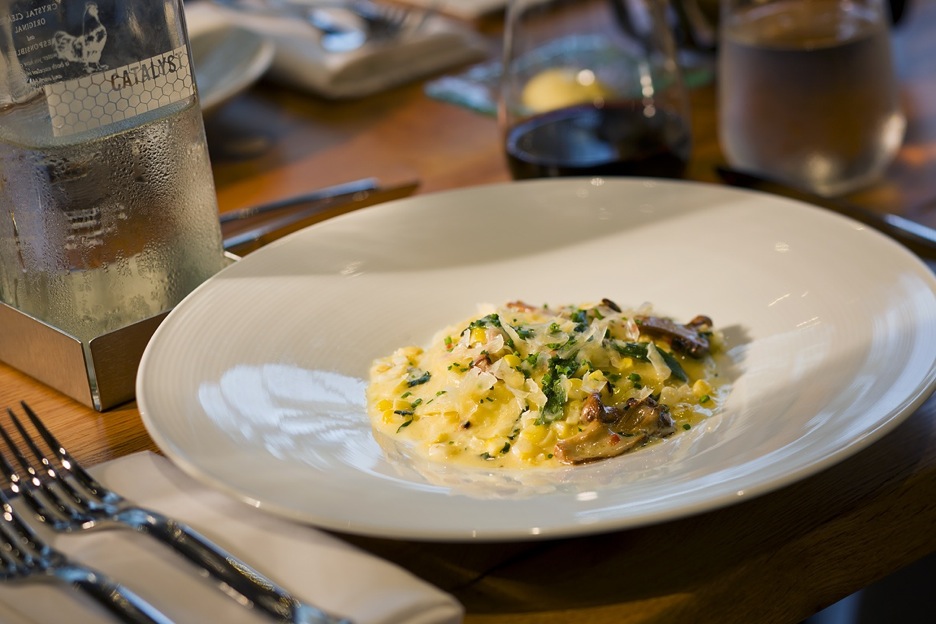 sea, from lakes to forest, starting
with juicy, meaty crispy quail with black Mission
fig, mizuna
greens, and, a sweet-acidic gastrique that
cut the richness of the dish. The Jerusalem
artichoke (so named not because it came from
Jerusalem--it's an American vegetable--but because
in Italy it was called girasole ["turns to the sun"],
which got mis-translated into English as Jerusalem
artichoke) was made into a creamy but light soup
with a good portion of lobster and a dash of curry
oil to evoke Boston's historic spice trade.
sea, from lakes to forest, starting
with juicy, meaty crispy quail with black Mission
fig, mizuna
greens, and, a sweet-acidic gastrique that
cut the richness of the dish. The Jerusalem
artichoke (so named not because it came from
Jerusalem--it's an American vegetable--but because
in Italy it was called girasole ["turns to the sun"],
which got mis-translated into English as Jerusalem
artichoke) was made into a creamy but light soup
with a good portion of lobster and a dash of curry
oil to evoke Boston's historic spice trade.
Two pastas were first-rate: Very
sweet Georgia squash filled tortellini,
served alongside braised escarole and shavings of
Parmigiano. Mushroom ravioli (right) included
hen of the woods along with a reduction of Madeira
wine and 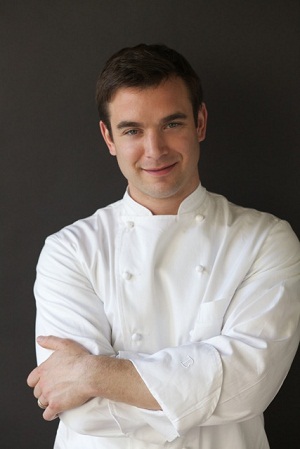 garlic-rich aïoli.
garlic-rich aïoli.
Koval (left) spit-roasts his chicken, giving it a perfect golden crisp skin all over, and he serves it with chanterelles, green beans, bacon, pearl onions, a little thyme, and potatoes to soak up the chicken drippings. He glazes a thick Berkshire pork chop with cider then buoys it with mustard-flavored spätzle, sauerkraut and a Courtland apple puree--a dish that reminds you that sauerkraut and apples, along with cider, are the perfect complements to pork. The French fries here are well worth the extra six bucks.
This summer, the desserts include butterscotch and passion fruit pudding with warm pound cake croutons; chocolate fondant, caramel glaze, hazelnut streusel and banana coulis; and a vanilla Coke float with braised cherries and peppermint.
Catalyst is open for lunch and dinner. Dinner
starters $9-$15, main courses $15-$27.
The
Bristol Lounge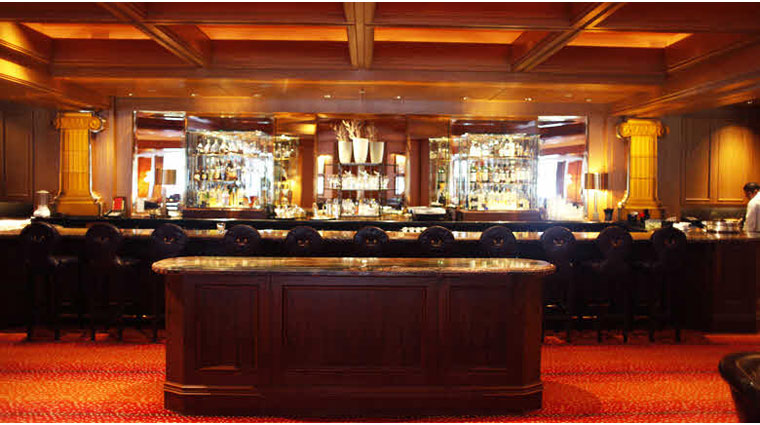
Four Seasons Hotel
200 Boylston Street
617-338-4400
Over the last three
decades, the dining options at The Four Seasons, whose
main restaurant used to be called Aujourd'hui, has
gone through plenty of changes of décor, style
and chefs. Right now it is called the Bristol
Lounge, and they have hit upon what I think is the
right balance of the casual and the sophisticated,
and, under exec chef Brooke Vosika, the menu
reflects an ideal
combination of superb New England and global cuisines
within an amiable dining room set against the sunny
backdrop of the Boston Commons in full bloom right
now. The restaurant is also known for having the
most lavish Sunday brunch in the city.
My wife and I were there for a
Saturday lunch, and from first course through dessert
we were impressed with the fresh ideas and
impeccable ingredients used here. Lunch is also a good
time to go because prices are somewhat cheaper.
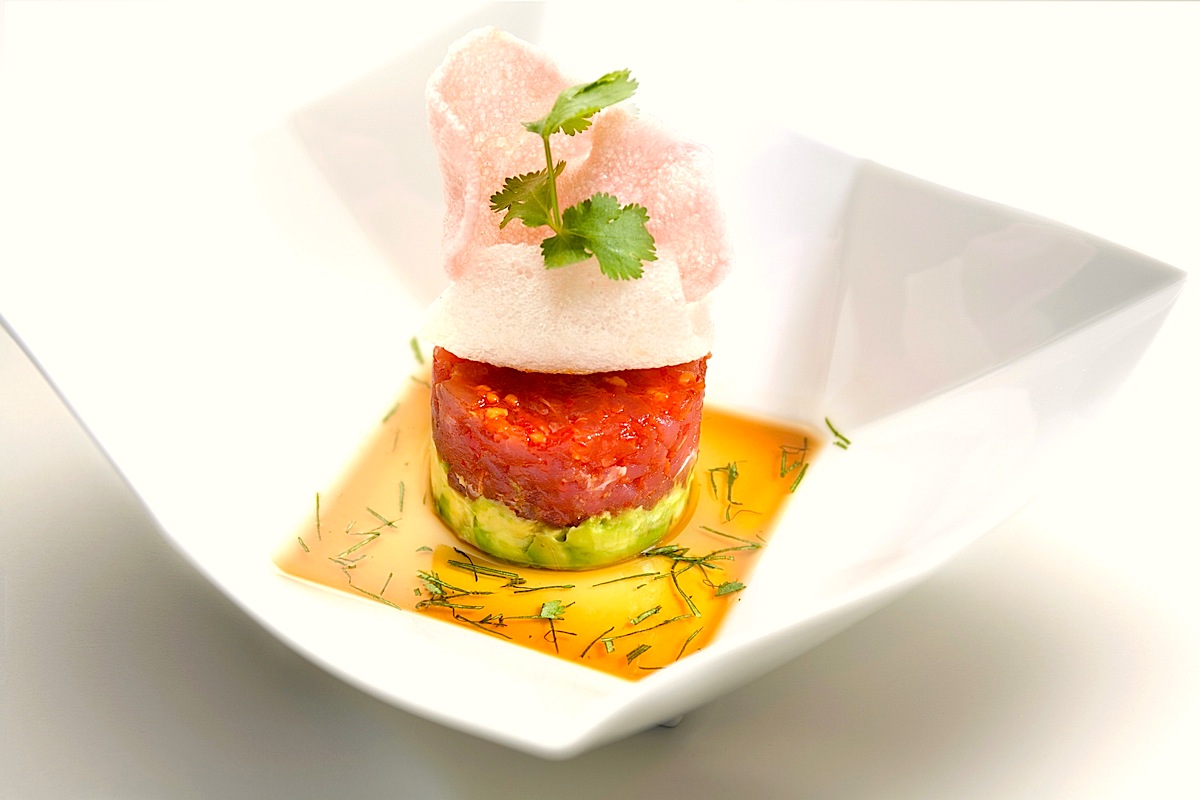 Our
first bite of ahi
tuna tartare (left)
with avocado, crisp rice noodles, and toasted peanuts
told us all we needed to know about how executive
sous-chef Jose Gamez captures his flavors and binds
them into one glorious whole. The tuna was of superb
quality, the avocado soft and sweet, the noodles added
Asian texture, and the peanuts another. Three
onion soup was laced with apple brandy and decadently
thick with excellent Gruyère cheese, the onions
themselves the color and sweetness of true
caramel. A mushroom tamale with chanterelles
came with a mild salsa and almond puree. This is
Boston, so the lobster roll is ubiquitous. The
Bristol's, at $30, justifies itself by being as chock
full of lobster meat as a triple-decker sandwich is
with turkey and bacon, and it is treated to a tangy
lemon sabayon instead of the usual mayonnaise, served
on a garlic-scented bun and with sweet potato fries
that go perfectly.
Our
first bite of ahi
tuna tartare (left)
with avocado, crisp rice noodles, and toasted peanuts
told us all we needed to know about how executive
sous-chef Jose Gamez captures his flavors and binds
them into one glorious whole. The tuna was of superb
quality, the avocado soft and sweet, the noodles added
Asian texture, and the peanuts another. Three
onion soup was laced with apple brandy and decadently
thick with excellent Gruyère cheese, the onions
themselves the color and sweetness of true
caramel. A mushroom tamale with chanterelles
came with a mild salsa and almond puree. This is
Boston, so the lobster roll is ubiquitous. The
Bristol's, at $30, justifies itself by being as chock
full of lobster meat as a triple-decker sandwich is
with turkey and bacon, and it is treated to a tangy
lemon sabayon instead of the usual mayonnaise, served
on a garlic-scented bun and with sweet potato fries
that go perfectly.
We also enjoyed seared diver
scallops, just past translucence, sweet and fat from
cold Atlantic waters, and it came in a defiantly New
England corn and clam chowder with marble potatoes and
prosciutto chips.
It was a terrific lunch and would
have made just as fine a dinner. At a time when
so many Boston restaurants have completely shed their
more civilized amenities, The Bristol Lounge is a
reminder of just how far refinement without pretension
will and should go.
The Bristol Lounge is open for
breakfast, lunch and dinner. At lunch starters run
$12-$20, sandwiches $20-$30, main courses $27-$39.
TRADE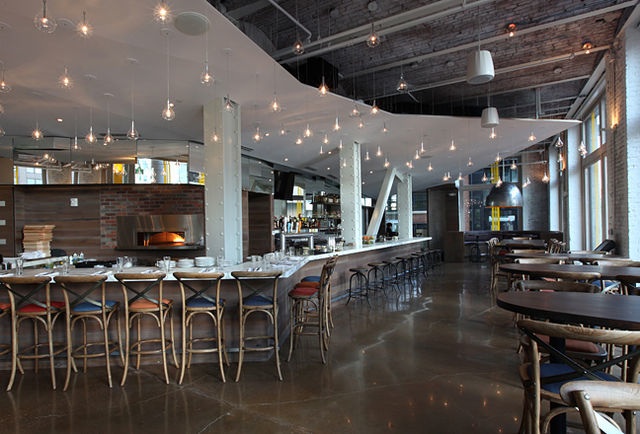
540
Atlantic Avenue
617-451-1234
trade-boston.com
The menu is huge and so is the
dining room, and the kitchen crew, headed by exec chef
Andrew Hebert (below,
with Adams), is not large, so not
everything that comes out of that kitchen has the same
degree of finesse. Some dishes taste somewhat
flat, others needed a little extra time to bring into
focus. But there are so many tasty options here
that you can pretty much point your finger anywhere,
order a mess of small plates--which range from
$8-$12--and do just fine. You're very likely to love
the
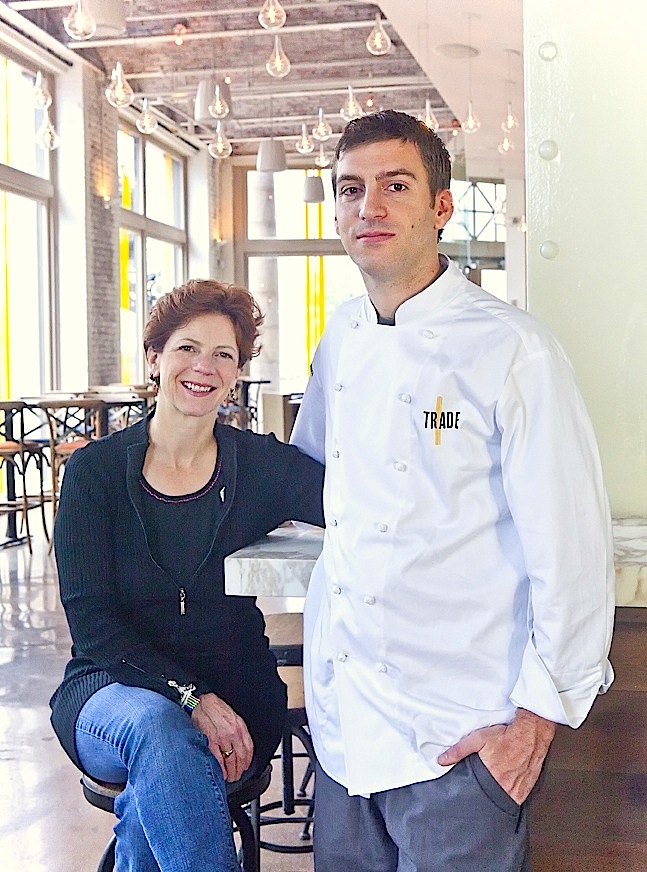 There is a
selection of five flatbreads at Trade, including ones
with rosemary, ricotta salata and sea
salt and a good rendering with mushrooms and
figs with Gorgonzola, sage
pesto and walnuts. You might also consider the
There is a
selection of five flatbreads at Trade, including ones
with rosemary, ricotta salata and sea
salt and a good rendering with mushrooms and
figs with Gorgonzola, sage
pesto and walnuts. You might also consider the 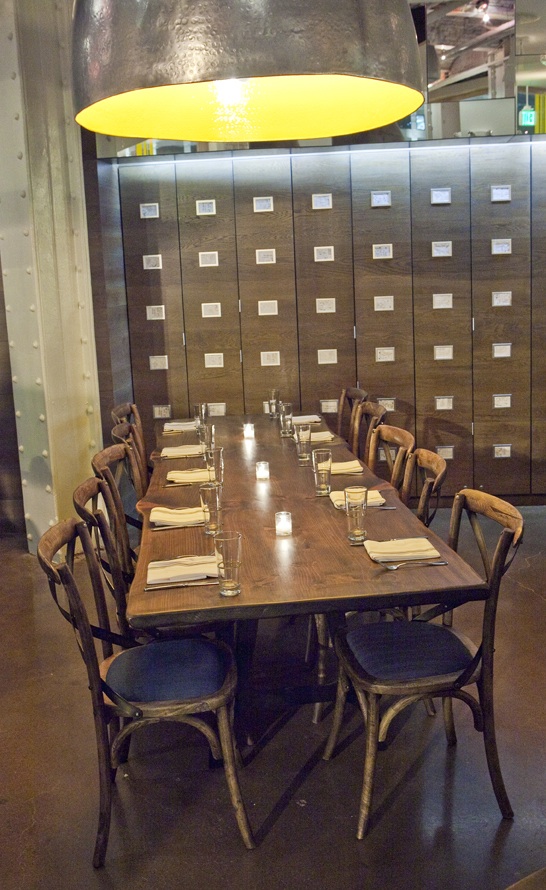 section "A
Little Extra" of small plates, and the roasted
cauliflower with curry,
raisins and cilantro; roasted asparagus with romesco, aleppo and
chervil; and crispy potatoes with paprika and cumin will go fast at
any table.
section "A
Little Extra" of small plates, and the roasted
cauliflower with curry,
raisins and cilantro; roasted asparagus with romesco, aleppo and
chervil; and crispy potatoes with paprika and cumin will go fast at
any table.
The larger plates run from
a good whole roasted
trout with a canny
assemblage of grilled pineapple, sweet plantains
and coriander, and there's a lot to like about the
braised short rib with sunchokes, oranges and olives.
Surprisingly, baked rigatoni with spicy lamb ragù and
provolone wasn't much out of the ordinary from what
you might find in Boston's Little Italy eateries.
Pastry Chef Sarah Cravedi has a nimble
way with desserts like chocolate budino with sea
salt, rosemary and hazelnut wafer, and a terrific
honey-roasted crostada
of ripe pears with crème fraîche and
caramel.
TRADE has been a very big hit
early on, and I hope that management can manage to get
the flow and the consistency right, meaning they might
take fewer customers at peak periods.
Trade is open for lunch and dinner Mon.-Fri, for
dinner Sat. & Sun.
Small plates $8-$16, large plates $16-$31.
MIEL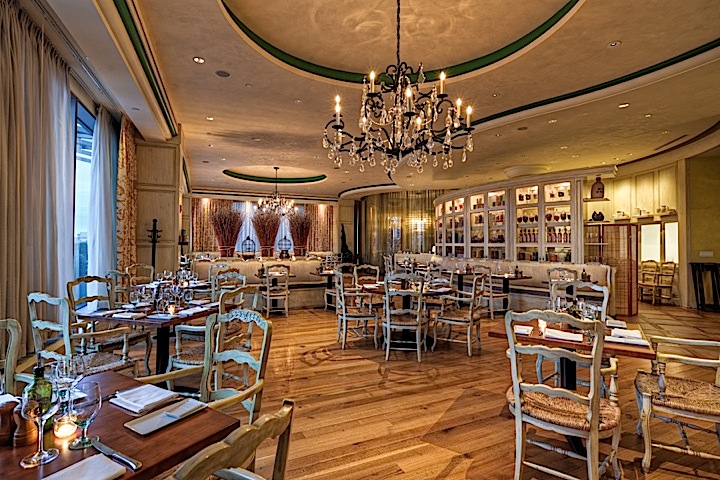
InterContinental Boston Hotel
510 Atlantic Avenue
617-217-5151
www.intercontinentalboston.com
Boston's
waterfront is nowhere better appreciated than from a
table at Miel Brasserie in the five-year-old
InterContinental Hotel, located on the site where the
Boston Tea Party took place in 1773 (a brand new
Museum celebrating the event has just opened there).
In fact, the hotel is offering a Boston Tea Party
Experience package from now through December at $329 a
night for a deluxe room and museum tickets, among
other amenities. The hotel is also ideally
located within steps of the Boston Children's Museum,
the new developments at Five Point Channel, and most
of the other historic sites along the
waterfront. The hotel's spacious rooms are
extremely well situated and the glass walls throughout
give them several panoramas from different
angles. There is also a pool and 6,600-square
foot spa here.
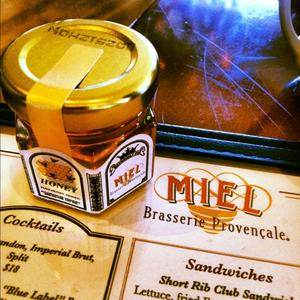 There are actually three restaurants at
the hotel: the bright and colorful Sushi Teq, whose
name references its emphasis on Japanese sushi and
Mexican tequilas (with salsa dancing encouraged);
RumBa, a circular bar, with a hidden Champagne Lounge
within mahogany walls, that stocks more than 100 rums
from around the world and offers a raw bar of
appetizers throughout the day.
There are actually three restaurants at
the hotel: the bright and colorful Sushi Teq, whose
name references its emphasis on Japanese sushi and
Mexican tequilas (with salsa dancing encouraged);
RumBa, a circular bar, with a hidden Champagne Lounge
within mahogany walls, that stocks more than 100 rums
from around the world and offers a raw bar of
appetizers throughout the day.
Miel Brasserie is for breakfast,
lunch and dinner, and at midday my wife and I, having
walked our feet off that morning, were happy to sit
behind the wall of glass and stare out at the sunny
waterfront (had it been warmer we would have been
outside on the deck) and put ourselves in the hands of
Chef Devanand Chinta, a Frenchman well schooled in all
the classics of Provençal cuisine, here based
on the New England cornucopia, which includes the
hotel's own apiary on the roof (the honey is
excellent, indeed). The wine list is solid and of
particular interest to those who enjoy rosé
wines. Adjacent to Miel (which means "honey") there is
also an olive oil museum, reflecting further on the
link between the menu and Provence. In fact, the
cooking here involves no butter at all, which I think
doctrinaire, but we really didn't miss it in the food.
There some perfectly prepared old
favorites here, not least the croque monsieur
sandwich, made with thick brioche bread sandwiching an
ooze of Mornay sauce and incredibly rich Saint
André cheese, with a sunny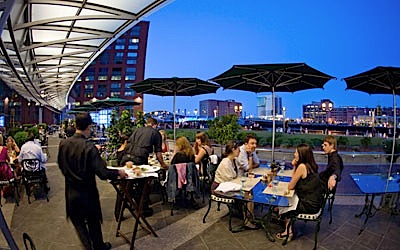 side up egg on top--two
could share this with a glass of wine for lunch.
Root vegetables are roasted in honey and served with
prosciutto, olive tapenade, and basted egg, while a
crêpe jambon
et fromage was lavished with béchamel
over honey ham, Swiss cheese and hearty short rib hash
and baby arugula.
side up egg on top--two
could share this with a glass of wine for lunch.
Root vegetables are roasted in honey and served with
prosciutto, olive tapenade, and basted egg, while a
crêpe jambon
et fromage was lavished with béchamel
over honey ham, Swiss cheese and hearty short rib hash
and baby arugula.
What's not to love about baked
sweet potato and lobster with mushrooms. onion and a
blast of cayenne in the crust? Or a mac and cheese
crockpot with truffle peel, Gruyère and fontina
cheese? For something a tad lighter, there is
very finely grained pan-seared tuna Mentonaise with
potatoes in olive oil, pesto, and hard-boiled eggs.
For desserts, you may lighten up
still further with a cup of summer berries or throw
caution to the wind and go for the delicious
crêpe with Nutella chocolate and sautéed
bananas.
Then sit back, take in the
waterfront sunshine and life, and prepare for a good
long walk till sundown.
Miel
is open for lunch and dinner daily, with brunch on
Sat. & Sun.Lunch appetizers run $8-$16, entrees
$12-$16.
A GREAT NEW BAR WITH GOOD EATS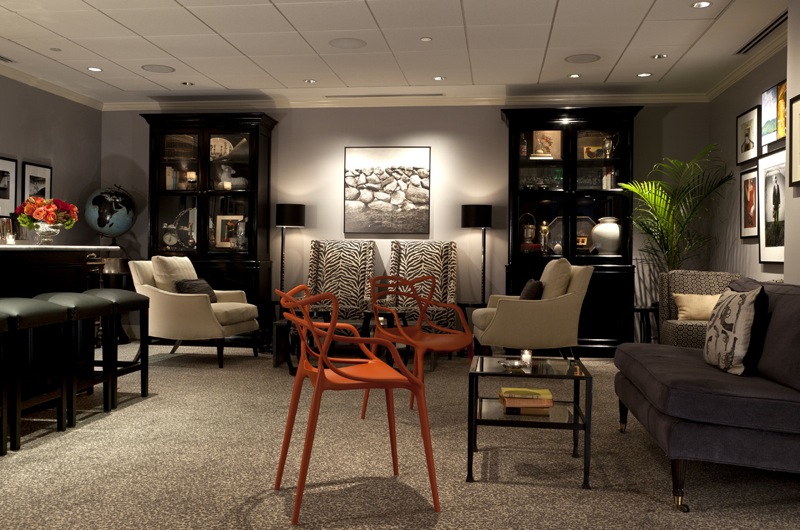
The Hawthorne,
adjacent to the Commonwealth Hotel (500A Commonwealth)
and happily just up the street from Fenway Park,
has won justified popularity for its swank main
bar and its rear room, much quieter, with cushions on
couches and zebra-fabric sofas, dazzling modern
photography, and a small bar making signature
cocktails. You can actually rent the room out by the
hour for a private cocktail party. The finger
food is some of the best in Boston, too. Before
or after a Sox game, this is the perfect place to roar
or rave, but keep it down a bit in the rear room.
❖❖❖
NEW YORK CORNER
by
John Mariani
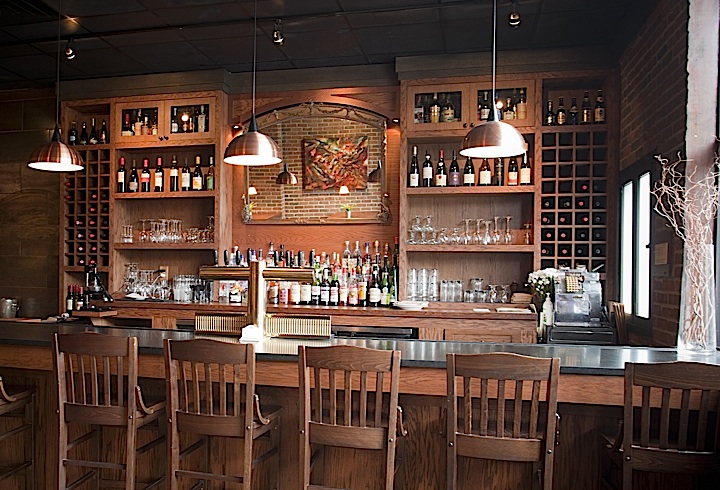 GWYNNETT ST.
GWYNNETT ST.
312
Graham Avenue (near
Devoe Street)
347-889-7002
www.gwynnettst.com
Missouri-born, McCoy garnered his love of food from his Sicilian grandfather and trips throughout Europe.
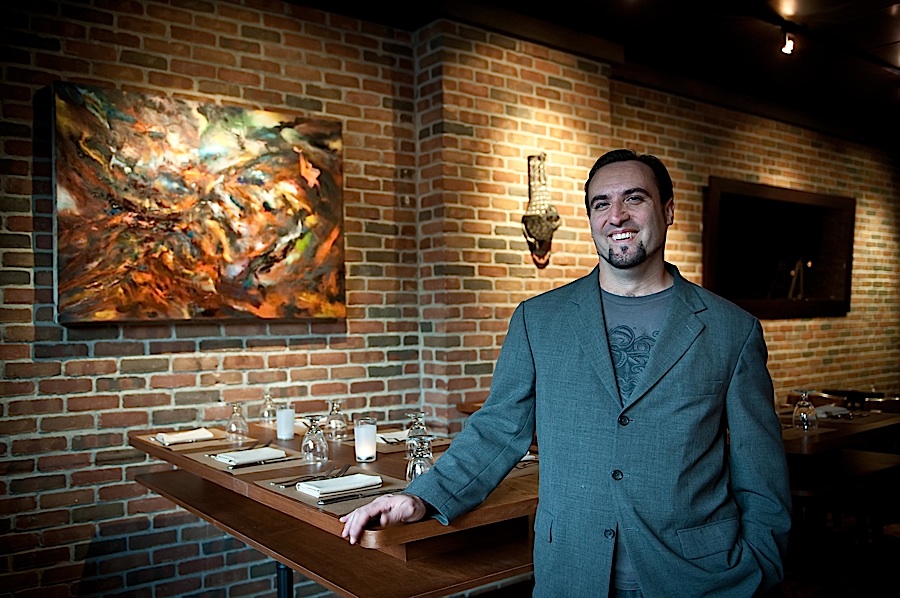 After working at
others' restaurants in Philly, McCoy moved to NYC, where
he became wine director at Esca, and now, his own dream
has been realized at Gwynnett St. His chef is
Justin Hilbert (below),
whose résumé includes stints on the Isle
of Wight, Mugaritz in Spain and WD-50 in Manhattan; Owen
Clark is sous-chef, and the bar manager is Brooklyn
native Doug Mancini, who offers a slew of signature
cocktails with punning names like Kingston Trio, Thick
as Thieves, and Rye Thai.
After working at
others' restaurants in Philly, McCoy moved to NYC, where
he became wine director at Esca, and now, his own dream
has been realized at Gwynnett St. His chef is
Justin Hilbert (below),
whose résumé includes stints on the Isle
of Wight, Mugaritz in Spain and WD-50 in Manhattan; Owen
Clark is sous-chef, and the bar manager is Brooklyn
native Doug Mancini, who offers a slew of signature
cocktails with punning names like Kingston Trio, Thick
as Thieves, and Rye Thai.In so many ways Gwynnett St. typifies and goes beyond the idea of a neighborhood restaurant whose patrons might all be locals just looking for a good burger and a few brewskis. The exterior is nothing to get your hopes up, but once inside you'll feel very much at home. The music is not loud--and it's good jazz--the signature cocktails are of interest, the service staff well-informed but never in that over-explanatory, recitative style so wonderfully satirized by Joel Stein in a comic piece in this week's New Yorker:
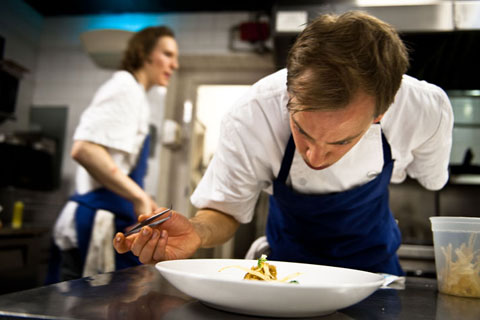 “Welcome. Have you dined with
us before?” “No. It’s our first time.” “Oh, that’s
adorable. Well, I’m sure you’ve been to other
restaurants, right?” “Uh, sure. Yes.” “Great. Well, none
of that restaurant experience will help you tonight.
Because we do things a little differently here.” “That’s
OK. We like different.” “I’ll guide you through the
process. First of all, we ask a lot of questions
designed to make you feel insecure. Is everyone at the
table O.K. with feeling insecure?” “That’s why we go out
to eat!”
“Welcome. Have you dined with
us before?” “No. It’s our first time.” “Oh, that’s
adorable. Well, I’m sure you’ve been to other
restaurants, right?” “Uh, sure. Yes.” “Great. Well, none
of that restaurant experience will help you tonight.
Because we do things a little differently here.” “That’s
OK. We like different.” “I’ll guide you through the
process. First of all, we ask a lot of questions
designed to make you feel insecure. Is everyone at the
table O.K. with feeling insecure?” “That’s why we go out
to eat!”The dinner menu lists seven starters and six entrees, with nightly specials. There is a tasting menu at a very reasonable $85, with wines $110. The first item on the appetizer list is a little off-putting: whiskey bread and cultured butter, which is sensationally delicious, but it'll cost you five bucks, and no other bread is offered. (Yeah, but it's worth it.) A soy bean and pistachio soup with rhubarb and butter is an ideal summer savory, each element in balance with the rest. "Pea Shoots and Leaves" is an equally delightful mélange of snap peas, radishes, curds and whey, so homey you want to keep repeating its name and ingredients like a nursery rhyme. Calf's tongue, so hard to find on menus, is velvety and full of flavor,
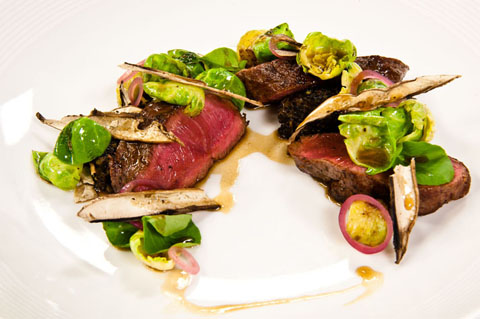 served with summer's
beans, cucumber and watercress. There seems a touch of
the much ballyhooed new forage-driven Nordic cuisine
here, although no one really knows just what that is.
served with summer's
beans, cucumber and watercress. There seems a touch of
the much ballyhooed new forage-driven Nordic cuisine
here, although no one really knows just what that is.
Given the simple goodness of Hilbert's dishes, our table of three was torn over whether to order an Amish chicken with buttermilk and ash, or a duck breast with wild rice, bell pepper and gooseberries. We chose the latter and found it absolutely perfect in its idea and resolution: the duck breast was cooked to medium rare, the skin crisp, and the addition of the rice (though I think they might spare a few more grains on the plate), the sweet pepper and juicy berries was a triumph. On the same par was a plate of perfect scallops (which can can be pretty boring if not in peak seasonal sweetness) served with bright zucchini, sorrel and the surprise of sweet blue crab. A bavette steak (right) had just the right
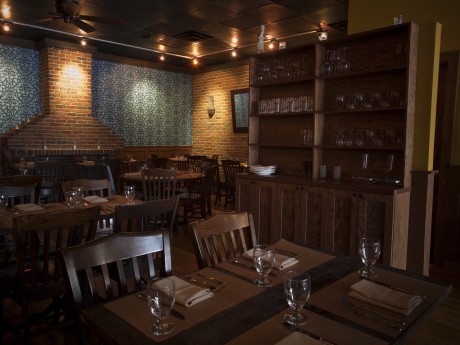 chewiness this underutilized cut should have, and it
was enriched with bone marrow and alliums, that is,
onion and garlic shoots and bulbs to add a bouquet and
sharp flavor.
chewiness this underutilized cut should have, and it
was enriched with bone marrow and alliums, that is,
onion and garlic shoots and bulbs to add a bouquet and
sharp flavor.Gwynnett St.'s desserts keep impeccably to the style of what goes before them: cherry sorbet with foam and candied cherries and coffee sponge cake with almond toffee coffee sauce; milk chocolate ganache with peanut butter crumble praline and foam, candied black currants and black currant sorbet; and cashew cream with apricot sorbet, and a meringue (odd, really) of birch bark and granules.
Gwynnett St.'s wine list is printed on one page, so every bottle is carefully chosen to go with Hilbert's food, and the staff cheerfully encourages you to sample a glass for under $10. Otherwise, there are many bottle options under $50.
What I enjoyed was a decidedly summer menu, and it makes me wonder what autumnal enchantments await. Restaurants in Brooklyn have found it easy enough to be lovable, but Gwynnett St. is doing distinguished food without a whit of pretense and at prices that make a trip out there well worth it.
Gwynnett Street is open for dinner nightly. Appetizers run $5-$16; entrees $20-$29.
France’s Third Best White
Wine Is Perfect for Summer
by John Mariani
Photos
courtesy of BICV and Interloire: Louis-Marie
Blanchard
If that comes as a surprise to those devotees of Alsatian rieslings and Rhône Valley viogniers, I will vigorously argue my point with you over a glass of each. But for me, good Sancerre—and there is a lot of bad Sancerre—gives me a greater degree of sheer happiness than the rest of those fine white bottlings, and, unlike them, Sancerre can be drunk with just about anything shy of charcoal-grilled steak or lamb.
With any seafood, Sancerre’s brisk, vegetal and mineral flavors marry impeccably. With most appetizers, even foie gras, it is a worthy complement. With chicken, there are few wines to match it. And as an aperitif before dinner, it’s a wine that perks up the appetite and may be carried to the dinner table with ease.
This is certainly not the case with sauvignon blancs in most other parts of the world, especially New Zealand, where the varietal is a major export, and California and Oregon examples range so widely in style that they are hard to say anything definitive.
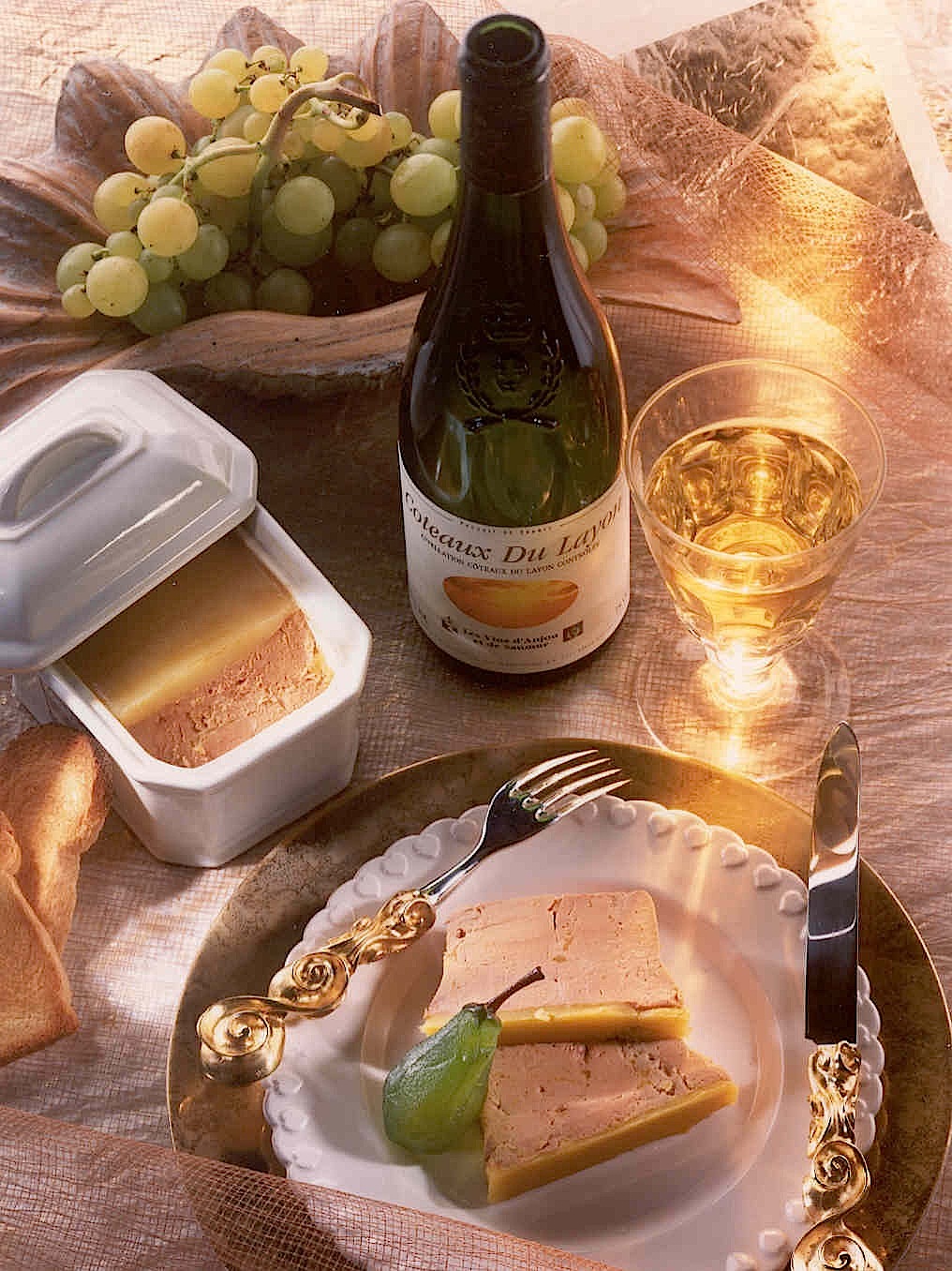
Good Sancerre has the fruit most people love in a white wine, the acid to keep it bright and fresh, the minerals to give it complexity, and the price to make it affordable for just about any size gathering.
Sancerre is a very large appellation in France’s Loire Valley region, and there is considerable variation in the vineyards and terroirs. Those around the town of Sancerre have the flintiest soil, while vineyards to the west produce more delicate wines, and those farthest west make the richest wines. The mix of flint and chalky soils gives the wines what the French called “pierre au fusil.”
Traditionally, Sancerre was vinified bone dry, buoyed by the minerality and herbaceous flavors, but in the last decade, with global warming in play, the wines have taken on more fruitiness from increased sugars. Still their alcohol by volume is rarely much above 13 percent. The Valley also produces red and rose Sancerres but they are typically modest wines.
I rounded up a passel of Sancerres and drank them with everything from a Cobb salad to beer-battered shrimp. Here are my notes on them:
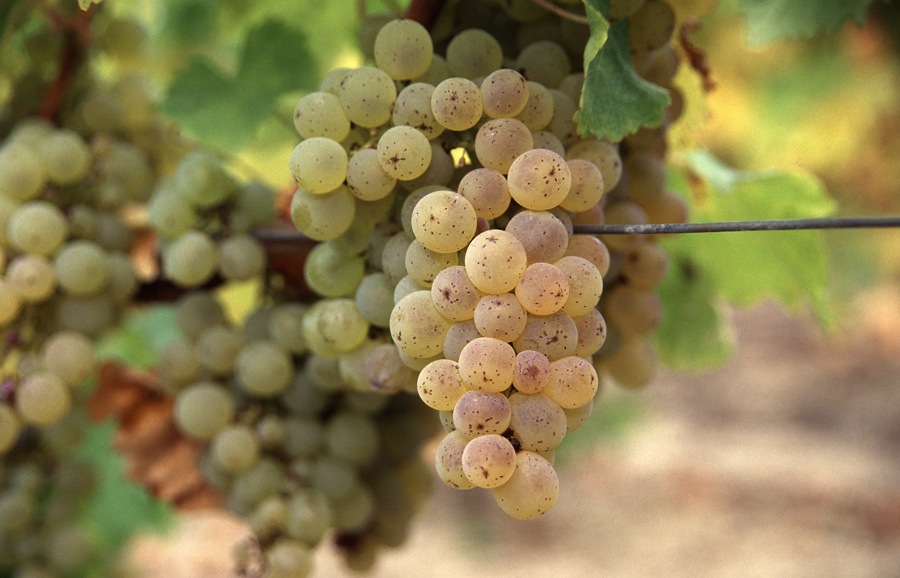 Domaine
Fournier Sancerre “Cuvée Silex” 2008
($40)— Between them, Éliane and Claude Fournier
share 13 generations of viniculture, and, with 150
acres of vineyards, tradition and expertise show. Can
Sancerre age well? This four-year old vintage proves
it can when made by Fournier. Its elements are subtle,
but they add up to a wine that is French sunshine in a
glass, with beautiful color and nose, and long-lasting
on the palate.
Domaine
Fournier Sancerre “Cuvée Silex” 2008
($40)— Between them, Éliane and Claude Fournier
share 13 generations of viniculture, and, with 150
acres of vineyards, tradition and expertise show. Can
Sancerre age well? This four-year old vintage proves
it can when made by Fournier. Its elements are subtle,
but they add up to a wine that is French sunshine in a
glass, with beautiful color and nose, and long-lasting
on the palate.
Domaine Fournier
Père & Fils Grande Cuvée Vielles
Vignes 2008 ($27)–This “old vines” Sancerre
shares the Cuvée Silex’s richness and adds to
it. They cool down the must before fermentation and
let it sit on the lees for half a day to impart
richness. It is in impeccable shape right now and
makes for a fine wine with creamy cheeses like
Camembert and Brie.
Domaine Fournier Sancerre
“Les Belles Vignes” 2010 ($20-$23)— Fourier’s
bargain Sancerre—made from 15 to 20 year old vines--a
splendid mix of flinty minerals and lush fruit, a wine
ideal for chicken dishes and wild salmon.
Pascal Jolivet Sancerre
2010 ($16-22)—For a winery only founded in
1987, Pascal Jolivet makes enchanting, very versatile
Sancerre from an ideal soil mixture of 50 percent
limestone, 30 percent chalky clay, and 20 percent
flint, all of which give it a fresh, spicy nose and
green spring flavors like new grass. It’s always sold
at a very decent price, too.
Picard Sancerre 2010 ($20-$22)—Since
the 17th century the Picard family has made
wines in the Loire Valley, and they continue to
produce a limited amount of wine of which their
Sancerre is an elegant example, with light ginger
notes.
Baron de Ladoucette
Sancerre “Comte Lafond” 2010 ($28-$36)—Long a
champion of the modern style in the Loire,
the estate’s Sancerres are known for their well-knit
spices and acids, along with flowery bouquet and long
finish at the back of the palate. With shellfish, it
is superb.
Clos de la Poussie 2010 ($32)—If
you like bone dry wine of the old school, this is your
Sancerre. The vineyards were until recently in
terrible shape, when this vintage was produced, but
now appear to be much healthier. I found the wine’s
only virtue was its crisp, citrusy acids but beyond
that its dryness was merely bland.
Domaine Thomas Sancerre
La Crele 2010 ($25)—Its very pale color may
fool you, for this is a big, full-fruited wine, made
from old vines, with 13.5 percent alcohol. It’s what
they should be aiming for in New Zealand and
California, and if you like that style, try this for a
lot more finesse.
Foucher-Lebrun Sancerre
Le Mont 2010 ($15)—What a bargain for a bold,
floral example of Sancerre from a small producer, with
a perfect balance of fruit and acid and a refreshingly
dry finish.
❖❖❖
 ANNALS OF THE ELITE
FRENCH POLICE-- SARTRE SAYS, 'EAT THIS!"
ANNALS OF THE ELITE
FRENCH POLICE-- SARTRE SAYS, 'EAT THIS!"
“Jean-Paul]
Sartre (right)
was a straight-out fellow traveler with the P.C.F.,
the Parti Comministe Français, and Albert Camus
was not. Sartre was outraged on behalf of the Party by
such episodes as the `affair of the carrier pigeons,’
in which the Party Secretary was found with pigeons in
his car and was accused by the police of using them,
like a good revolutionary, to coordinate illegal
demonstrations. (It turned out that, like a good
Frenchman, he was merely planning a squab
casserole.)”—Adam Gopnick, “Facing History,” The New Yorker
(4/9).
ZILLIONS OF LONE STAR TICKS!
❖❖❖
Any of John Mariani's
books below may be ordered from amazon.com.
 |
My latest book, which just won the prize for best book from International Gourmand, written with Jim Heimann and Steven Heller, Menu Design in America, 1850-1985 (Taschen Books), has just appeared, with nearly 1,000 beautiful, historic, hilarious, sometimes shocking menus dating back to before the Civil War and going through the Gilded Age, the Jazz Age, the Depression, the nightclub era of the 1930s and 1940s, the Space Age era, and the age when menus were a form of advertising in innovative explosions of color and modern design. The book is a chronicle of changing tastes and mores and says as much about America as about its food and drink.
“Luxuriating vicariously in the pleasures of this book. . . you can’t help but become hungry. . .for the food of course, but also for something more: the bygone days of our country’s splendidly rich and complex past. Epicureans of both good food and artful design will do well to make it their coffee table’s main course.”—Chip Kidd, Wall Street Journal.
“[The menus] reflect the amazing craftsmanship that many restaurants applied to their bills of fare, and suggest that today’s restaurateurs could learn a lot from their predecessors.”—Rebecca Marx, The Village Voice. |
"Eating Italian will never be the same after reading John Mariani's entertaining and savory gastronomical history of the cuisine of Italy and how it won over appetites worldwide. . . . This book is such a tasteful narrative that it will literally make you hungry for Italian food and arouse your appetite for gastronomical history."--Don Oldenburg, USA Today. "Italian
restaurants--some good, some glitzy--far
outnumber their French rivals. Many of
these establishments are zestfully described
in How Italian Food Conquered the World, an
entertaining and fact-filled chronicle by
food-and-wine correspondent John F.
Mariani."--Aram Bakshian Jr., Wall Street
Journal.
"Equal parts
history, sociology, gastronomy, and just
plain fun, How Italian Food Conquered the
World tells the captivating and delicious
story of the (let's face it) everybody's
favorite cuisine with clarity, verve and
more than one surprise."--Colman Andrews,
editorial director of The Daily
Meal.com. "A fantastic and fascinating
read, covering everything from the influence
of Venice's spice trade to the impact of
Italian immigrants in America and the
evolution of alta cucina. This book will
serve as a terrific resource to anyone
interested in the real story of Italian
food."--Mary Ann Esposito, host of PBS-TV's
Ciao
Italia. "John Mariani has written the
definitive history of how Italians won their
way into our hearts, minds, and
stomachs. It's a story of pleasure over
pomp and taste over technique."--Danny Meyer,
owner of NYC restaurants Union Square Cafe,
Gotham Bar & Grill, The Modern, and
Maialino.
|
 |
 |
 |
 |
 |
 |
 |
 |
❖❖❖
 Everett Potter's Travel Report:
Everett Potter's Travel Report: 
 Eating Las Vegas
is the new on-line site for Virtual Gourmet
contributor John A. Curtas., who since 1995
has been commenting on the Las Vegas food
scene and reviewing restaurants for Nevada
Public Radio. He is also the
restaurant critic for KLAS TV, Channel 8 in
Las Vegas, and his past reviews can be
accessed at KNPR.org.
Click on the logo below to go directly to
his site.
Eating Las Vegas
is the new on-line site for Virtual Gourmet
contributor John A. Curtas., who since 1995
has been commenting on the Las Vegas food
scene and reviewing restaurants for Nevada
Public Radio. He is also the
restaurant critic for KLAS TV, Channel 8 in
Las Vegas, and his past reviews can be
accessed at KNPR.org.
Click on the logo below to go directly to
his site.

Tennis Resorts Online: A Critical Guide to the World's Best Tennis Resorts and Tennis Camps, published by ROGER COX, who has spent more than two decades writing about tennis travel, including a 17-year stretch for Tennis magazine. He has also written for Arthur Frommer's Budget Travel, New York Magazine, Travel & Leisure, Esquire, Money, USTA Magazine, Men's Journal, and The Robb Report. He has authored two books-The World's Best Tennis Vacations (Stephen Greene Press/Viking Penguin, 1990) and The Best Places to Stay in the Rockies (Houghton Mifflin, 1992 & 1994), and the Melbourne (Australia) chapter to the Wall Street Journal Business Guide to Cities of the Pacific Rim (Fodor's Travel Guides, 1991).


MARIANI'S VIRTUAL GOURMET
NEWSLETTER is published weekly. Editor/Publisher: John
Mariani.
Contributing Writers: Christopher Mariani, Robert Mariani,
John A. Curtas, Edward Brivio, Mort Hochstein,
Suzanne Wright, and Brian Freedman. Contributing
Photographers: Galina Stepanoff-Dargery,
Bobby Pirillo. Technical Advisor: Gerry McLoughlin.
To un-subscribe from this newsletter,click here.
© copyright John Mariani 2012
